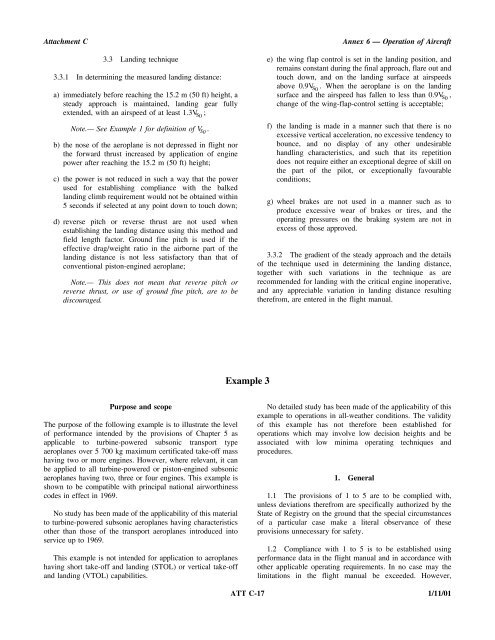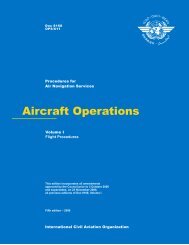Operation of Aircraft
Annex 6, Part I
Annex 6, Part I
- No tags were found...
You also want an ePaper? Increase the reach of your titles
YUMPU automatically turns print PDFs into web optimized ePapers that Google loves.
Attachment C<br />
3.3 Landing technique<br />
3.3.1 In determining the measured landing distance:<br />
a) immediately before reaching the 15.2 m (50 ft) height, a<br />
steady approach is maintained, landing gear fully<br />
extended, with an airspeed <strong>of</strong> at least 1.3V S 0 ;<br />
Note.— See Example 1 for definition <strong>of</strong> V S 0 .<br />
b) the nose <strong>of</strong> the aeroplane is not depressed in flight nor<br />
the forward thrust increased by application <strong>of</strong> engine<br />
power after reaching the 15.2 m (50 ft) height;<br />
c) the power is not reduced in such a way that the power<br />
used for establishing compliance with the balked<br />
landing climb requirement would not be obtained within<br />
5 seconds if selected at any point down to touch down;<br />
d) reverse pitch or reverse thrust are not used when<br />
establishing the landing distance using this method and<br />
field length factor. Ground fine pitch is used if the<br />
effective drag/weight ratio in the airborne part <strong>of</strong> the<br />
landing distance is not less satisfactory than that <strong>of</strong><br />
conventional piston-engined aeroplane;<br />
Note.— This does not mean that reverse pitch or<br />
reverse thrust, or use <strong>of</strong> ground fine pitch, are to be<br />
discouraged.<br />
Annex 6 — <strong>Operation</strong> <strong>of</strong> <strong>Aircraft</strong><br />
e) the wing flap control is set in the landing position, and<br />
remains constant during the final approach, flare out and<br />
touch down, and on the landing surface at airspeeds<br />
above 0.9V S 0<br />
. When the aeroplane is on the landing<br />
surface and the airspeed has fallen to less than 0.9V S 0 ,<br />
change <strong>of</strong> the wing-flap-control setting is acceptable;<br />
f) the landing is made in a manner such that there is no<br />
excessive vertical acceleration, no excessive tendency to<br />
bounce, and no display <strong>of</strong> any other undesirable<br />
handling characteristics, and such that its repetition<br />
does not require either an exceptional degree <strong>of</strong> skill on<br />
the part <strong>of</strong> the pilot, or exceptionally favourable<br />
conditions;<br />
g) wheel brakes are not used in a manner such as to<br />
produce excessive wear <strong>of</strong> brakes or tires, and the<br />
operating pressures on the braking system are not in<br />
excess <strong>of</strong> those approved.<br />
3.3.2 The gradient <strong>of</strong> the steady approach and the details<br />
<strong>of</strong> the technique used in determining the landing distance,<br />
together with such variations in the technique as are<br />
recommended for landing with the critical engine inoperative,<br />
and any appreciable variation in landing distance resulting<br />
therefrom, are entered in the flight manual.<br />
Example 3<br />
Purpose and scope<br />
The purpose <strong>of</strong> the following example is to illustrate the level<br />
<strong>of</strong> performance intended by the provisions <strong>of</strong> Chapter 5 as<br />
applicable to turbine-powered subsonic transport type<br />
aeroplanes over 5 700 kg maximum certificated take-<strong>of</strong>f mass<br />
having two or more engines. However, where relevant, it can<br />
be applied to all turbine-powered or piston-engined subsonic<br />
aeroplanes having two, three or four engines. This example is<br />
shown to be compatible with principal national airworthiness<br />
codes in effect in 1969.<br />
No study has been made <strong>of</strong> the applicability <strong>of</strong> this material<br />
to turbine-powered subsonic aeroplanes having characteristics<br />
other than those <strong>of</strong> the transport aeroplanes introduced into<br />
service up to 1969.<br />
This example is not intended for application to aeroplanes<br />
having short take-<strong>of</strong>f and landing (STOL) or vertical take-<strong>of</strong>f<br />
and landing (VTOL) capabilities.<br />
No detailed study has been made <strong>of</strong> the applicability <strong>of</strong> this<br />
example to operations in all-weather conditions. The validity<br />
<strong>of</strong> this example has not therefore been established for<br />
operations which may involve low decision heights and be<br />
associated with low minima operating techniques and<br />
procedures.<br />
1. General<br />
1.1 The provisions <strong>of</strong> 1 to 5 are to be complied with,<br />
unless deviations therefrom are specifically authorized by the<br />
State <strong>of</strong> Registry on the ground that the special circumstances<br />
<strong>of</strong> a particular case make a literal observance <strong>of</strong> these<br />
provisions unnecessary for safety.<br />
1.2 Compliance with 1 to 5 is to be established using<br />
performance data in the flight manual and in accordance with<br />
other applicable operating requirements. In no case may the<br />
limitations in the flight manual be exceeded. However,<br />
ATT C-17 1/11/01












